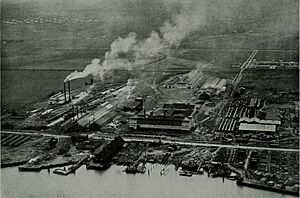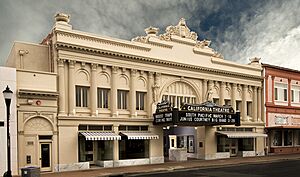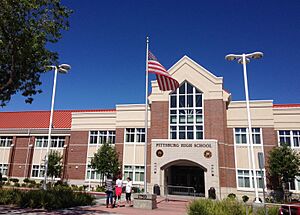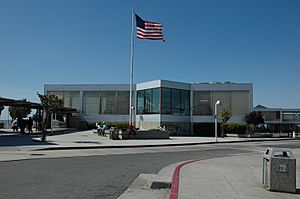Pittsburg, California facts for kids
Quick facts for kids
Pittsburg
|
||
|---|---|---|

The Boardwalk
|
||
|
||
| Nickname(s):
"P-World" "The Burg"
|
||
| Motto(s):
Gateway to the Delta!
|
||

Location in Contra Costa County and the state of California
|
||
| Country | United States | |
| State | California | |
| County | Contra Costa | |
| Incorporated | June 25, 1903 | |
| Government | ||
| • Type | General Law City | |
| Area | ||
| • Total | 19.71 sq mi (51.05 km2) | |
| • Land | 17.64 sq mi (45.69 km2) | |
| • Water | 2.07 sq mi (5.36 km2) 10.11% | |
| Elevation | 26 ft (8 m) | |
| Population
(2020)
|
||
| • Total | 76,416 | |
| • Density | 4,332/sq mi (1,672.5/km2) | |
| Time zone | UTC-8 (PST) | |
| • Summer (DST) | UTC-7 (PDT) | |
| ZIP code |
94565
|
|
| Area code(s) | 925 | |
| FIPS code | 06-57456 | |
| GNIS feature IDs | 1659783, 2411430 | |
Pittsburg is a city in Contra Costa County, California, United States. It used to be called Black Diamond, New York Landing, and New York of the Pacific. Pittsburg is an industrial suburb located on the southern shore of the Suisun Bay. This area is part of the San Francisco Bay Area. In 2020, about 76,416 people lived here.
Contents
History of Pittsburg
The area was first settled in 1839. It was known as “Rancho Los Medanos.” This land was given to Jose Antonio Mesa and his brother Jose Miguel. They received it from the Mexican Governor Juan Bautista Alvarado.
In 1849, during the California Gold Rush, Colonel Jonathan D. Stevenson bought the land. He was from New York. He planned a town and named it "New York of the Pacific." General William Tecumseh Sherman designed the first streets. This spot was a popular stop for schooners. These boats traveled from San Francisco to the gold country. Fishing, farming, and raising cattle were the main jobs then.
Coal Mining and Fishing Industries
In 1859, coal was found nearby in Nortonville. Pittsburg then became a port for coal. The Black Diamond Coal Mining Company started operations. They built the Black Diamond Coal Mining Railroad. This railroad moved coal to the docks. These docks were called "Black Diamond Landing." The coal boom ended in 1885.
In the 1870s, commercial fishing became important. The Black Diamond Cannery opened. By 1882, ten canneries were in the Sacramento Delta. Fishing became a big industry. Many Sicilian immigrants worked in fishing. Their families have lived here for many years. In 1957, California stopped commercial fishing in the Delta. This ended the local fishing industry.
Pittsburg's Industrial Growth
In 1900, C.A. Hooper bought the land. He started many factories. In 1903, he created the Industrial Center of the West. Hooper helped the Columbia Steel Company open. In 1910, their California steel plant opened in Pittsburg. It started with 60 employees. They made steel parts for different industries.
In 1903, the town became a city. People voted to name it "Black Diamond." This was after the mining company. But in 1909, a new name was suggested. On February 11, 1911, the city was renamed "Pittsburg." This honored Pittsburgh, Pennsylvania. Both cities had a history in steel and mining.
In 1930, Columbia Steel became part of U.S. Steel. The Pittsburg plant grew a lot. It had 5,200 employees by the early 1950s. Later, U.S. Steel joined with a Korean company. They invested a lot of money. The Pittsburg plant became a modern steel mill. It was renamed USS-Posco. In 1999, it had 970 workers. It shipped over 1.6 million tons of steel each year.
Pittsburg's Growth and Development
The original town was on the Sacramento/San Joaquin River Delta. This was because it was a river port. Since the early 1900s, the city has grown inland. It also spread along State Route 4. This road is now a freeway. It helps people travel to jobs in the San Francisco Bay-Oakland area. The town of Cornwall, California was absorbed as Pittsburg grew. In 2000, the city had 56,769 people.
Camp Stoneman was built in 1942. It was a big military base. The United States Army used it during World War II and the Korean War. It closed in 1954. The first post office opened in 1868 as Black Diamond. Its name changed to Pittsburg in 1911.
Geography and Climate
Pittsburg is next to Bay Point, California on the west. It borders Concord, California to the southwest. Antioch, California is to the east. The Suisun Bay is north of the city. It connects the San Francisco Bay to the Sacramento and San Joaquin rivers.
Pittsburg's Climate
Pittsburg has a hot summer Mediterranean climate. This means it has warm, dry summers. It has mild, wet winters. The Mt. Diablo mountain range affects the weather. It creates a "rain shadow." This makes East Contra Costa County drier.
| Climate data for Pittsburg, California | |||||||||||||
|---|---|---|---|---|---|---|---|---|---|---|---|---|---|
| Month | Jan | Feb | Mar | Apr | May | Jun | Jul | Aug | Sep | Oct | Nov | Dec | Year |
| Mean daily maximum °F (°C) | 55.2 (12.9) |
60.6 (15.9) |
64.7 (18.2) |
70.1 (21.2) |
76.0 (24.4) |
82.0 (27.8) |
87.2 (30.7) |
87.0 (30.6) |
83.6 (28.7) |
76.3 (24.6) |
64.8 (18.2) |
56.2 (13.4) |
72.0 (22.2) |
| Mean daily minimum °F (°C) | 39.9 (4.4) |
42.2 (5.7) |
45.0 (7.2) |
47.6 (8.7) |
51.7 (10.9) |
55.4 (13.0) |
57.3 (14.1) |
57.6 (14.2) |
56.4 (13.6) |
51.6 (10.9) |
44.5 (6.9) |
39.8 (4.3) |
49.1 (9.5) |
| Average precipitation inches (mm) | 3.52 (89) |
3.41 (87) |
2.56 (65) |
1.15 (29) |
0.60 (15) |
0.12 (3.0) |
0.00 (0.00) |
0.03 (0.76) |
0.10 (2.5) |
0.79 (20) |
1.71 (43) |
3.38 (86) |
17.37 (440.26) |
Pittsburg's Population
| Historical population | |||
|---|---|---|---|
| Census | Pop. | %± | |
| 1890 | 300 | — | |
| 1900 | 603 | 101.0% | |
| 1910 | 2,372 | 293.4% | |
| 1920 | 4,715 | 98.8% | |
| 1930 | 9,610 | 103.8% | |
| 1940 | 9,520 | −0.9% | |
| 1950 | 12,763 | 34.1% | |
| 1960 | 19,062 | 49.4% | |
| 1970 | 21,423 | 12.4% | |
| 1980 | 33,034 | 54.2% | |
| 1990 | 47,564 | 44.0% | |
| 2000 | 56,769 | 19.4% | |
| 2010 | 63,264 | 11.4% | |
| 2020 | 76,416 | 20.8% | |
| U.S. Decennial Census | |||
Population in 2020
The 2020 United States Census showed Pittsburg had 77,572 people. This means about 4,323 people lived in each square mile. The population was made up of many different groups. About 27.3% were White. About 15.2% were African American. About 17.8% were Asian. About 1.2% were Native American. About 1.0% were Pacific Islander. About 7.2% were from other races. About 14.2% were from two or more races. People of Hispanic or Latino background made up 43.2% of the population.
| Race / Ethnicity | Pop 2000 | Pop 2010 | Pop 2020 | % 2000 | % 2010 | % 2020 |
|---|---|---|---|---|---|---|
| White alone (NH) | 17,697 | 12,684 | 11,888 | 31.17% | 20.05% | 18.9% |
| Black or African American alone (NH) | 10,457 | 10,756 | 12,441 | 18.42% | 17.00% | 15.2% |
| Native American or Alaska Native alone (NH) | 210 | 202 | 218 | 0.37% | 0.32% | 1.2% |
| Asian alone (NH) | 7,031 | 9,654 | 14,725 | 12.39% | 15.26% | 17.8% |
| Pacific Islander alone (NH) | 464 | 614 | 825 | 0.82% | 0.97% | 1.0% |
| Mixed Race or Multi-Racial (NH) | 2,433 | 2,336 | 3,502 | 4.29% | 3.69% | 4.52% |
| Hispanic or Latino (any race) | 18,287 | 26,841 | 32,300 | 32.21% | 42.43% | 43.2% |
| Total | 56,769 | 63,264 | 76,416 | 100.00% | 100.00% | 100.00% |
Population in 2010
In 2010, Pittsburg had 63,264 people. The population density was about 3,303 people per square mile. The city's population was very diverse. About 36.5% were White. About 17.7% were African American. About 15.6% were Asian. About 0.8% were Native American. About 1.0% were Pacific Islander. About 21.0% were from other races. About 7.3% were from two or more races. People of Hispanic or Latino origin made up 42.4% of the population.
Most people (99.5%) lived in homes. There were 19,527 households. About 45.3% of these had children under 18. The average household had 3.22 people. The average family had 3.64 people. The median age in Pittsburg was 32.5 years.
Population in 2000
In 2000, Pittsburg had 56,769 people. There were 17,741 households. About 42.2% of households had children under 18. The average household size was 3.17 people. The average family size was 3.59 people. The median age was 31 years.
The median income for a household was $50,557. For a family, it was $54,472. About 11.5% of the population lived below the poverty line. This included 14.1% of those under 18.
Pittsburg's Economy
Pittsburg's economy has long been linked to coal mining and industry. Today, major companies like USS-POSCO Industries are here. This company is a partnership between US Steel and POSCO from South Korea. Corteva also has plants in Pittsburg.
Top Employers in Pittsburg
Here are the top employers in Pittsburg as of 2020:
| # | Employer | # of Employees |
|---|---|---|
| 1 | Pittsburg Unified School District | 1,221 |
| 2 | Los Medanos College | 584 |
| 3 | USS-POSCO Industries | 570 |
| 4 | Dow Chemical Company | 350 |
| 5 | Ramar Foods | 370 |
| 6 | City of Pittsburg | 340 |
| 7 | Wal-Mart | 222 |
| 8 | Home-Depot | 188 |
| 9 | WinCo Foods | 168 |
| 10 | Cardenas (supermarket) | 143 |
Arts and Culture in Pittsburg
Museums and Theatres
The Pittsburg Historical Museum opened in 1961. Since 2003, it has been in the old Pittsburg Post Dispatch building.
The California Theatre opened in 1920. It first showed live vaudeville acts and silent films. Famous performers like Flash Gordon played there. Cowboy heroes like Ray “Crash” Corrigan also performed. The theatre closed in 1954. It was later renovated for $7.6 million in 2008. Another $2 million was spent in 2022. Today, it has 981 seats. It features beautiful ceiling decorations.
Pittsburg Festivals
- Pittsburg Seafood & Music Festival: This is an annual event. It happens every September. It started in 1984.
- Pittsburg Jazz, Blues and Funk Festival: A celebration of music.
- Pittsburg Car Show: Held from May to September each year. It features cool cars and live bands.
- Holiday Parade: An annual event in December. It includes city leaders and the Pittsburg High School Marching Band. There are also fun floats.
Public Libraries
Pittsburg has a library. It is part of the Contra Costa County Libraries system.
Sports in Pittsburg
The Pittsburg Diamonds was a professional baseball team. They played in the Pacific Association. This team played from 2014 to 2019. Their home games were at City Park Field #1. The team stopped playing in 2019. Now, Pittsburg does not have an independent baseball team.
Education in Pittsburg
Pittsburg is home to Los Medanos College. This is a two-year community college. It is part of the Contra Costa Community College District. The college's name comes from "Rancho Los Medanos." This was a land grant from Mexico. "Los Medanos" means "The Sand Dunes" in Spanish. The college was finished in 1974.
Public Schools in Pittsburg
Schools in Pittsburg are managed by the Pittsburg Unified School District. They include:
- Black Diamond Continuation High School
- Foothill Elementary School
- Heights Elementary School
- Highlands Elementary School
- Hillview Junior High School
- Los Medanos Elementary School
- Marina Vista Elementary School
- Martin Luther King Jr. High School
- Parkside Elementary School
- Pittsburg High School
- Rancho Medanos Junior High School
- Stoneman Elementary School
- Willow Cove Elementary School
Private Schools in Pittsburg
- The Christian Center
- School of Saint Peter Martyr
- Spectrum Center
Transportation in Pittsburg
Pittsburg has two BART stations. One is the Pittsburg/Bay Point station. It is near Bailey Road and Highway 4. The other is the Pittsburg Center Station. It is on Railroad Avenue and Highway 4. Tri Delta Transit offers bus service in the area. California State Route 4 goes through the city from west to east.
Notable People from Pittsburg
- Justin Baesman (born 1981), mixed martial artist
- Dante Basco (born 1975), actor
- Dion Basco (born 1977), actor; brother of Dante
- Toni Blackman, rapper
- Bert Bonanno (born 1940), track and field coach
- Marvin Burke (1918–1994), NASCAR driver
- Joe Canciamilla (born 1955), politician
- Cameron Colvin (born 1986), footballer
- John Coughran (born 1951), basketballer
- Xavier Crawford (born 1995), footballer
- Brian Dailey (born 1951), artist
- Darrell Daniels (born 1994), footballer
- Pete Escovedo (born 1935), percussionist
- Sal Esquivel (born 1948), businessman
- Rosie Gaines (born 1960), musician
- Donald George, operatic tenor
- Luis Gutierrez (born 1933), artist
- Shaunard Harts (born 1978), footballer
- Rydah J. Klyde, rapper
- Paul E. Koelliker (1943-2022), general authority of LDS Church
- Steve Lopez (born 1953), journalist
- Pat McNeil (born 1954), footballer
- Aaron Miles (born 1976), baseballer
- Dominick Newton (1977–2015), rapper better known as "The Jacka"
- Joe O'Brien (born 1972), footballer
- James "Mighty Quinn" Page (born 1971), boxer
- Avery Patterson, footballer
- Broderick Perkins (born 1954), baseballer
- Evan Pilgrim (born 1972), footballer
- Ken Simonton (born 1979), footballer
- Dave Stetson (born 1946), co-creator of Caricature Carvers of America
- Joe Tafoya (born 1978), footballer
- Altie Taylor (1947–2010), footballer
- Tony Teresa (1933–1984), footballer
- Mario Verduzco, football coach
- Karen Vogtmann (born 1949), mathematician
- Annabelle Wallis (born 1984), actress
- Keith Daniel Williams (1947–1996), murderer
- Stan Williamson (1909–1965), footballer
Sister Cities
Pittsburg has sister city relationships with:
 Isola delle Femmine, Italy
Isola delle Femmine, Italy Pohang, South Korea
Pohang, South Korea Shimonoseki, Japan
Shimonoseki, Japan Yahualica de González Gallo, Mexico
Yahualica de González Gallo, Mexico
See also
 In Spanish: Pittsburg (California) para niños
In Spanish: Pittsburg (California) para niños








